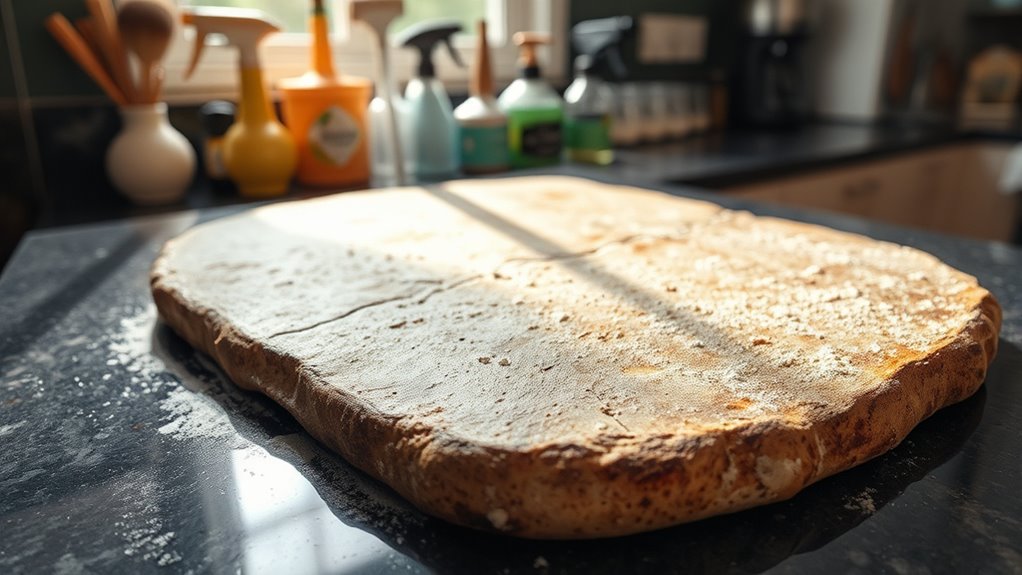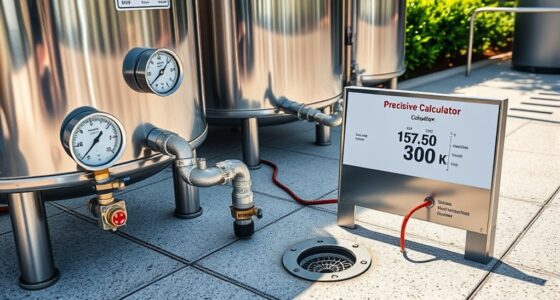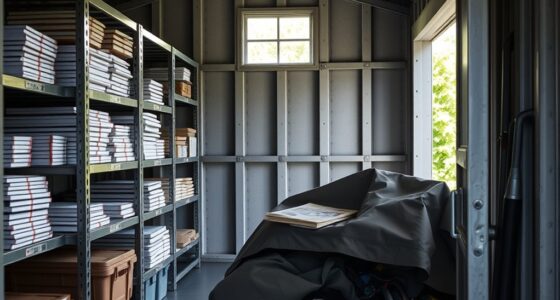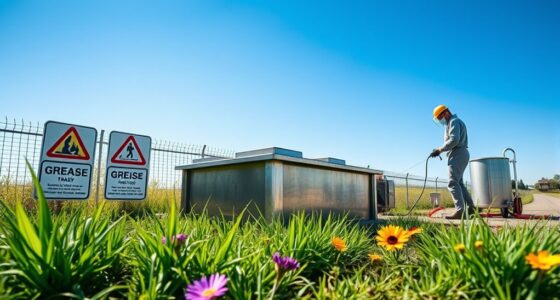If you use harsh cleaners, abrasive tools, or soak your pizza stone, you risk damaging its porous surface, which can lead to cracks and shorten its lifespan, costing you money to replace. Over-cleaning or ignoring residue can also cause bacteria buildup and structural weakening. Proper maintenance—like gentle brushing, thorough drying, and avoiding chemicals—helps extend your stone’s life and saves you money. Keep these tips in mind to avoid costly mistakes.
Key Takeaways
- Using harsh chemicals or abrasive tools can cause cracks, chips, and structural weakening, leading to costly replacements.
- Excessive water exposure weakens the porous stone, increasing the risk of cracks and breakage during heating.
- Over-cleaning or infrequent maintenance can trap residues or cause surface damage, reducing the stone’s lifespan and performance.
- Improper cleaning methods, like soaking or chemical use, can create health hazards and necessitate early replacement.
- Regular, proper maintenance extends the stone’s durability, preventing expensive repairs and ensuring safe, long-term use.
The Risks of Using Harsh Cleaners on Pizza Stones
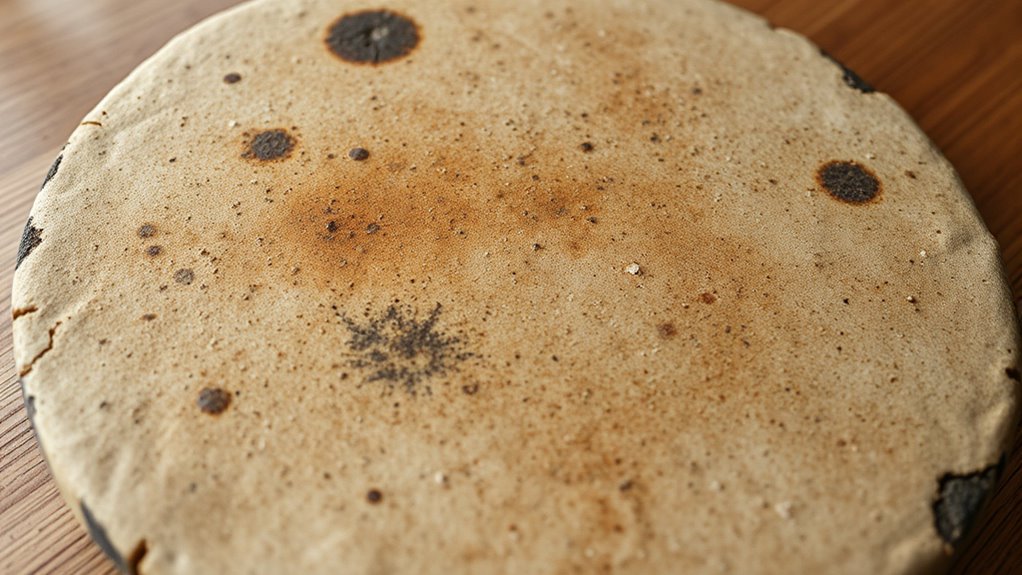
Using harsh cleaners on pizza stones can cause more harm than you might realize. These chemicals can leave behind dangerous chemical residue that’s difficult to remove, especially since pizza stones are highly porous. The surface porosity of the stone absorbs cleaning agents, trapping chemicals deep within its structure. This not only risks contaminating your food but also weakens the stone over time. Harsh cleaners can strip away the natural seasoning or protective layer, making the surface more vulnerable to damage. Instead of cleaning with aggressive chemicals, opt for gentle methods like brushing off debris or using a damp cloth. Protect your pizza stone’s integrity and your health by avoiding harsh cleaners that compromise surface porosity and introduce unwanted chemical residues. Additionally, understanding the importance of porosity maintenance can help you extend the lifespan of your pizza stone and keep it safe for food preparation.
Damage From Excessive Water Exposure

Exposing your pizza stone to excessive water can cause significant damage over time. Water damage occurs when moisture seeps into the porous material, weakening its structure and leading to cracks or breakage. If you soak or rinse your stone too thoroughly, it may retain moisture longer than it should, making it vulnerable to thermal shock when heated. Proper moisture control is essential; avoid immersing the stone in water or using too much liquid during cleaning. Instead, opt for dry brushing or wiping with a damp cloth. Allow the stone to dry completely before storing or reusing it. Keeping moisture levels in check helps prevent water damage, extends the life of your pizza stone, and maintains its cooking performance. Regularly monitoring material durability ensures your stone remains in good condition over time.
The Cost of Improper Scraping Techniques

Using the wrong scraping techniques can damage your pizza stone’s surface, making it more prone to cracks and chips. It also reduces cleaning effectiveness, leaving behind residues that affect future cooking. Over time, these mistakes can lead to higher replacement costs, costing you more in the long run. Incorporating proper cleaning methods can also promote self-awareness about your maintenance routines and help extend the lifespan of your pizza stone.
Damaging Stone Surface
When you scrape a pizza stone with improper techniques, you risk damaging its delicate surface. Using harsh tools or excessive pressure can cause scratching, chipping, or gouging, leading to cleaning damage that’s hard to repair. A rough or metal scraper might seem effective but often leaves permanent marks or removes the glaze, making the stone more porous and prone to absorbing oils and odors. This deterioration not only shortens the stone’s lifespan but can also affect your pizza’s quality. Proper scraping methods involve gentle tools and careful techniques to preserve the integrity of the stone surface. Ignoring these precautions results in damage that requires costly replacements and compromises your cooking results. Protect your investment by understanding how improper scraping harms your pizza stone. Additionally, understanding the proper maintenance of your pizza stone can help extend its useful life and maintain optimal performance.
Reducing Cleaning Effectiveness
Improper scraping techniques can substantially reduce your pizza stone’s ability to stay clean and perform well. When you scrape too aggressively or use the wrong tools, you risk pushing residue buildup deeper into the stone’s pores or damaging its surface. This makes it harder to remove stubborn debris, diminishing cleaning effectiveness over time. Additionally, inconsistent scraping can lead to uneven residue accumulation, which impacts heat distribution and cooking quality. If you don’t adjust your cleaning frequency appropriately, you’re either neglecting the buildup or over-cleaning, both of which harm the stone’s performance. Proper scraping techniques, combined with a balanced cleaning schedule, help maintain the stone’s integrity and ensure it continues to absorb moisture and heat effectively. Being aware of the cleaning strategies suitable for your specific stone type can further prolong its lifespan and efficiency.
Increasing Replacement Costs
Failing to use proper scraping techniques can substantially increase your pizza stone’s replacement costs. Aggressive scrubbing or harsh tools damage the stone’s material durability, leading to cracks and breakage. This forces you to replace the stone more frequently, undermining your goal of cost-effective cleaning. To avoid this, use gentle scraping tools and avoid metal scrapers that can chip or crack the surface. Consider the following:
| Proper Technique | Risk of Damage | Long-term Cost |
|---|---|---|
| Soft brush | Minimal damage | Saves money |
| Plastic scraper | Slight wear | Extends life |
| Metal scraper | High risk | Higher costs |
Choosing the right tools protects your investment and prevents unnecessary replacements. Additionally, understanding hackathon principles can inspire innovative solutions for maintaining your pizza stones more effectively.
Risks of Abrasive Cleaning Tools

Using abrasive cleaning tools on pizza stones can cause significant damage that might not be immediately visible. Abrasive tools, like steel wool or harsh scrubbing pads, can scratch or chip the stone’s surface, weakening its structure over time. Cleaning abrasives designed for tougher surfaces can leave scratches that compromise the stone’s porosity, leading to cracks or even breakage. These damages aren’t always obvious right away, but they reduce the stone’s lifespan and can affect cooking results. When you rely on abrasive tools, you risk creating tiny fractures that grow larger with each use, accelerating deterioration. Additionally, automation technologies are increasingly used in manufacturing processes, which can contribute to less durable products if not properly managed. To avoid these hidden costs, stick to gentle cleaning methods and avoid harsh abrasives that can undermine your pizza stone’s durability.
How Over-Soaking Can Lead to Cracks

Over-soaking your pizza stone might seem like a good way to loosen stubborn residues, but it can actually cause serious damage. When the stone absorbs too much moisture, it becomes vulnerable to stone cracking during the heating process. Rapid temperature changes cause the moisture trapped inside to expand quickly, putting stress on the stone’s structure. Additionally, the contrast ratio of the stone’s material can influence how it handles these thermal stresses, affecting its durability. Over time, this repeated moisture absorption and uneven drying can weaken the material, increasing the risk of cracks. These cracks compromise the stone’s integrity and may lead to breakage. To avoid this, keep cleaning sessions brief and avoid submerging your stone in water. Instead, opt for dry or lightly damp cleaning methods that prevent excessive moisture absorption and preserve your stone’s longevity.
The Hidden Expense of Replacing a Damaged Stone
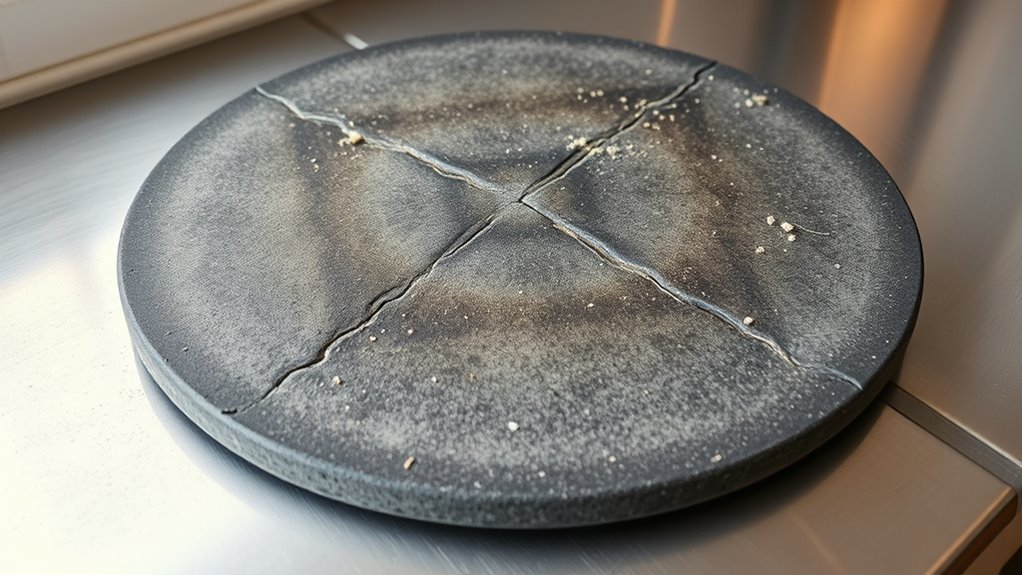
Replacing a damaged pizza stone can quietly drain your budget, especially since many people overlook the true cost involved. The costly replacement isn’t just the price of a new stone but also includes hidden expenses like shipping fees, handling costs, and potential damage during removal. If you ignore the signs of wear or mishandle the stone, you risk cracking it further, increasing the need for frequent replacements. Over time, these hidden expenses add up, making it more expensive than you might expect. Proper care and maintenance can help you avoid unnecessary replacements, saving you money in the long run. Additionally, understanding the shelf life of pizza stones and how to prolong their durability can help you make smarter choices and extend the life of your pizza stone, preventing avoidable expenses.
Misunderstanding the Cleaning Frequency Needs
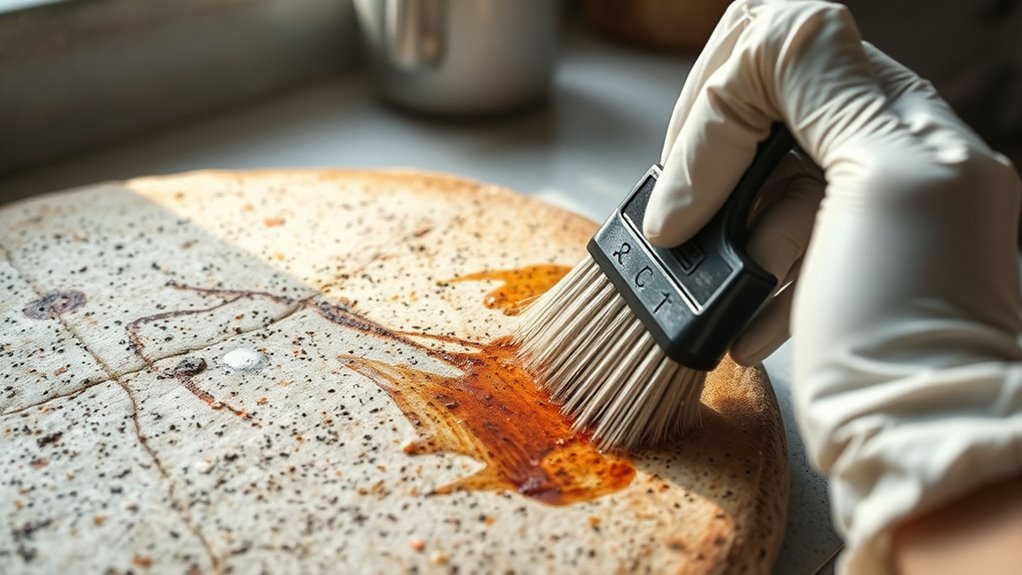
Cleaning your pizza stone too often can cause unnecessary wear and damage, leading to costly replacements. On the other hand, waiting too long for deep cleans can result in stubborn buildup that’s harder to remove. Finding the right balance is essential to avoid these hidden costs. Regular maintenance can help prevent the need for extensive cleaning sessions and prolong the lifespan of your pizza stone, especially by understanding proper cleaning frequency and techniques.
Overcleaning Risks
Many people mistakenly believe that frequent cleaning is necessary to keep their pizza stones in top condition, but overcleaning can actually do more harm than good. Excessive cleaning disrupts the stone’s natural porous surface, making it more prone to absorbing chemical residues from harsh cleaning agents. Rigid cleaning schedules often lead to unnecessary scrubbing, which can damage the stone’s structure and diminish its heat retention. Overcleaning also risks stripping away the thin layer of baked-on residue that protects the stone, leaving it vulnerable to staining and cracking. Instead, you should focus on cleaning only when necessary, using gentle methods. This approach preserves the stone’s integrity, reduces the risk of chemical residue buildup, and ensures it performs at its best over time.
Infrequent Deep Cleans
While infrequent deep cleans might seem sufficient to maintain your pizza stone, misunderstanding how often they’re needed can lead to problems. Skipping seasonal deep cleaning can cause stubborn stains and baked-on residue, affecting performance and flavor. To prevent this, know when to perform stain removal methods, such as scrubbing with a brush or baking soda paste. Here’s a quick guide:
| Frequency | Cleaning Focus | Methods |
|---|---|---|
| After every use | Surface debris | Wipe with damp cloth |
| Monthly | Light stains | Gentle scrubbing |
| Annually | Deep stains, buildup | Seasonal deep cleaning |
Ignoring these milestones may lead to uneven heating and compromised stone integrity. Proper timing guarantees lasting performance and flavor consistency.
The Impact of Ignoring Residual Food and Grease
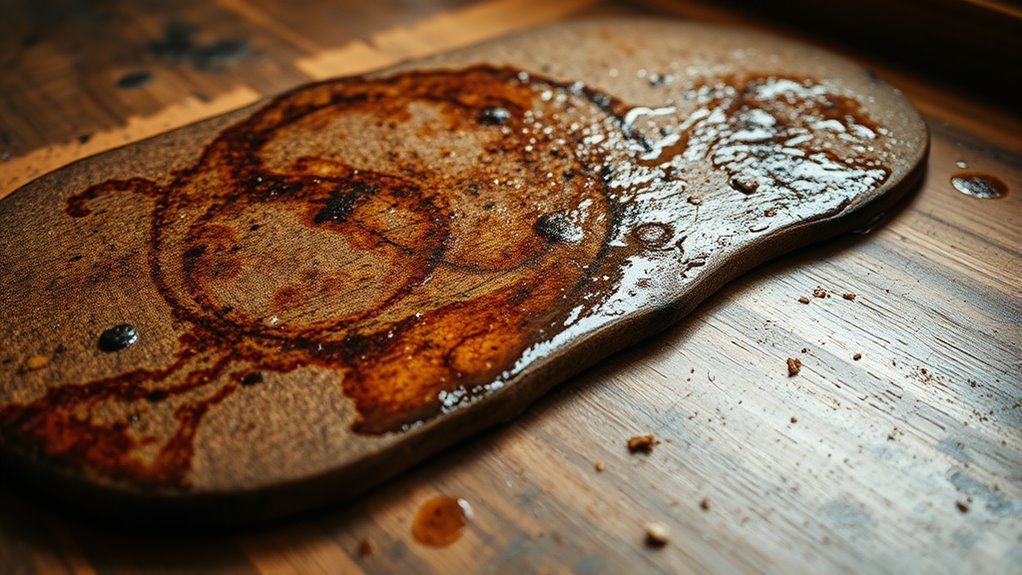
Residual food and grease left on your pizza stone can cause more than just unpleasant odors; they can also lead to serious health risks and damage the stone over time. Residual buildup from leftover food and grease accumulation creates a breeding ground for bacteria and mold, which can transfer to your food during future uses. Over time, these residues can also weaken the stone’s structure, causing cracks or warping. Ignoring this buildup may result in stubborn stains and an unpleasant smell that’s hard to eliminate. To prevent these issues, it’s crucial to clean the stone regularly, removing residual food and grease thoroughly. Doing so not only extends the life of your pizza stone but also ensures your cooking environment remains safe and hygienic.
Using the Wrong Cleaning Methods and Their Consequences
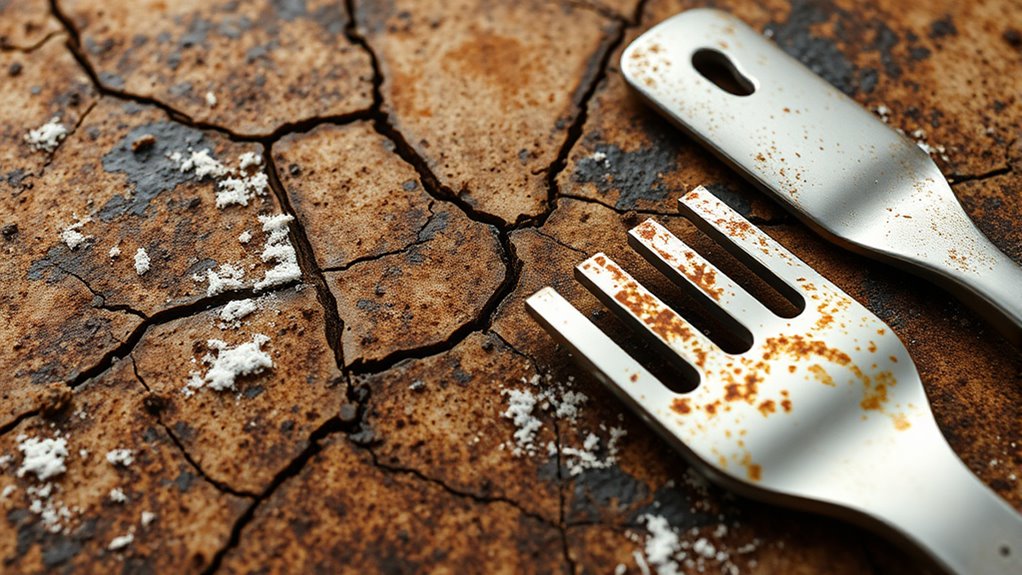
Using the wrong cleaning methods can do more harm than good, often damaging your pizza stone instead of cleaning it. Harsh chemicals or soap residues can leave behind chemical residues that linger and affect the flavor of future pizzas. Additionally, improper cleaning can cause odor buildup, making your stone smell unpleasant over time. Scrubbing with abrasive tools or using strong cleaners can create tiny cracks or remove the stone’s porous surface, reducing its effectiveness. These damages make it harder to clean later and can trap food particles and odors. Instead, stick to simple methods like brushing off debris and avoiding chemical cleaners. Proper cleaning not only preserves your stone’s integrity but also prevents the buildup of unwanted smells and residues that compromise your pizza experience.
Tips to Extend the Lifespan and Save Money

To get the most out of your pizza stone and save money, you should focus on proper cleaning techniques and consistent maintenance. By taking small steps regularly, you can prevent damage and extend its lifespan. These simple habits make a big difference over time.
Proper Cleaning Techniques
Proper cleaning techniques are essential for maintaining the quality and extending the lifespan of your pizza stone. Start by removing crumbs and loose debris with a brush or soft cloth after each use. Avoid using soap or harsh chemicals, as they can damage the seasoned seasoning and compromise the stone’s porous structure. Instead, gently scrub with a damp cloth or a stiff brush if needed. Once clean, let your pizza stone cool completely before proper storage to prevent cracks. Keeping it dry and in a well-ventilated area helps preserve its seasoning and prevents mold. Remember, a well-maintained pizza stone relies on proper cleaning and storage practices, which directly contribute to its durability and your savings over time.
Regular Maintenance Habits
Maintaining your pizza stone regularly can substantially extend its lifespan and save you money in the long run. Establishing a consistent cleaning schedule and seasonal maintenance routine prevents buildup and damage. For example, after each use, brush off crumbs and residues. Seasonally, do a deeper clean by removing stubborn stains and inspecting for cracks. Follow this simple table to stay on track:
| Frequency | Task | Tips |
|---|---|---|
| After each use | Light brushing and wiping | Avoid soap, use water if necessary |
| Weekly | Remove loose debris | Use a stiff brush |
| Monthly | Deep cleaning if needed | Use baking soda paste |
| Seasonal | Inspection and repairs | Replace if cracked or damaged |
Sticking to this routine helps prevent costly repairs and keeps your pizza stone in top shape.
Frequently Asked Questions
Can I Use Soap or Dishwashing Detergent on My Pizza Stone?
You shouldn’t use soap or dishwashing detergent on your pizza stone because dish soap risks leaving residues that can affect your food’s flavor. Cleaning with detergents can seep into the porous surface, making it unsafe for future use. Instead, scrub gently with a brush or a damp cloth, and avoid soaking it in water. Proper care keeps your pizza stone safe, clean, and ready for every delicious bake.
How Do I Know When My Pizza Stone Needs Cleaning?
You’ll know your pizza stone needs cleaning when you notice residue buildup or an unpleasant odor retention. Studies show that a dirty stone can harbor bacteria and affect food flavor. If your stone looks stained, feels sticky, or smells off after use, it’s time to clean. Regular inspection keeps your pizza tasting fresh and prevents hidden costs like damage or odor transfer, ensuring your stone stays in top shape.
Are There Eco-Friendly Cleaning Options for Pizza Stones?
Yes, you can use eco-friendly cleaning options for your pizza stone. Opt for biodegradable solutions like baking soda paste or natural cleaning methods such as scrubbing with a damp brush and salt. These methods effectively remove stains and residue without harsh chemicals, helping you maintain your stone’s integrity and the environment. Just remember to avoid soaking the stone and let it thoroughly dry before use.
What Are the Signs of a Cracked or Damaged Pizza Stone?
You’ll notice crack detection when your pizza stone develops visible lines or fissures that run across its surface. Damage indicators include bubbling, warping, or pieces chipping off during use or cleaning. If you see these signs, it’s time to contemplate replacing the stone, as continued use can lead to further damage or even breakage, which might cause safety issues or affect your pizza’s quality. Always inspect your stone regularly.
Is It Necessary to Reseason or Re-Clean My Pizza Stone Periodically?
You should reseason or re-clean your pizza stone periodically to maintain seasoning and prevent buildup. Regular cleaning frequency depends on how often you use it; after each use, let it cool and brush off crumbs. If you notice stubborn stains or odors, reseason to restore its non-stick surface. Proper seasoning maintenance helps prolong its life and ensures your pizza always comes out perfect.
Conclusion
By understanding these hidden costs and avoiding common cleaning pitfalls, you can keep your pizza stone in top shape for years. Proper care isn’t just about saving money—it’s about ensuring your baking results stay perfect. Are you ready to ditch harsh chemicals and risky techniques? With a little attention and the right methods, you’ll enjoy delicious homemade pizza without the costly repairs or replacements. Isn’t it worth preserving your trusty pizza stone’s longevity?
